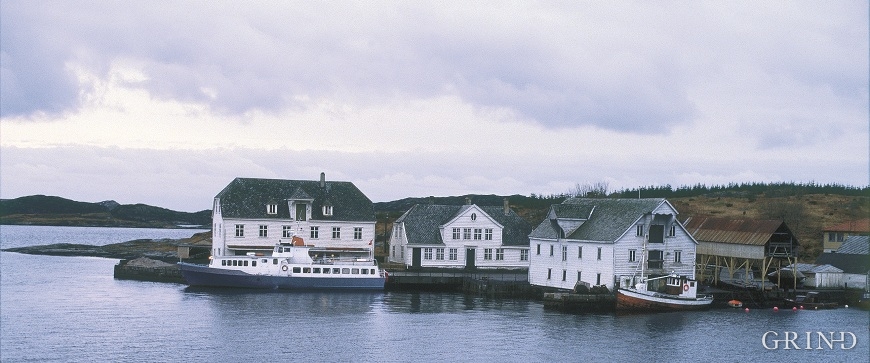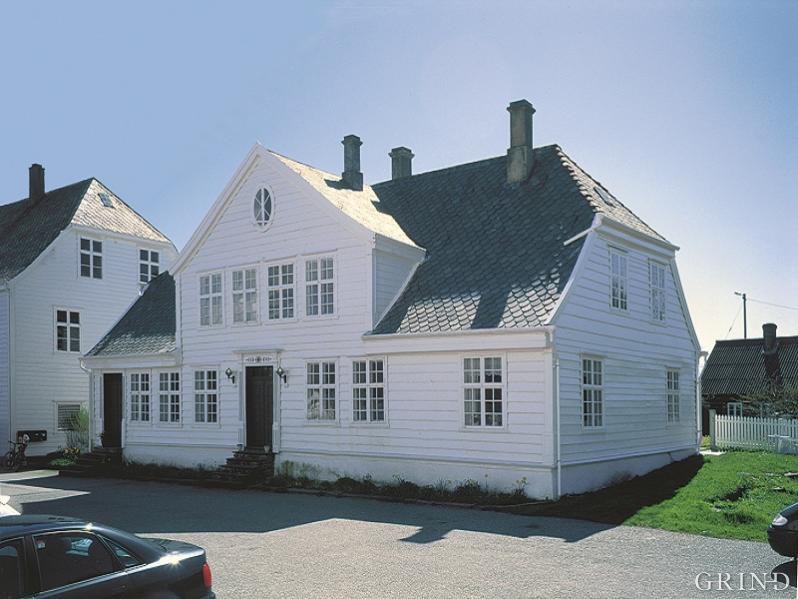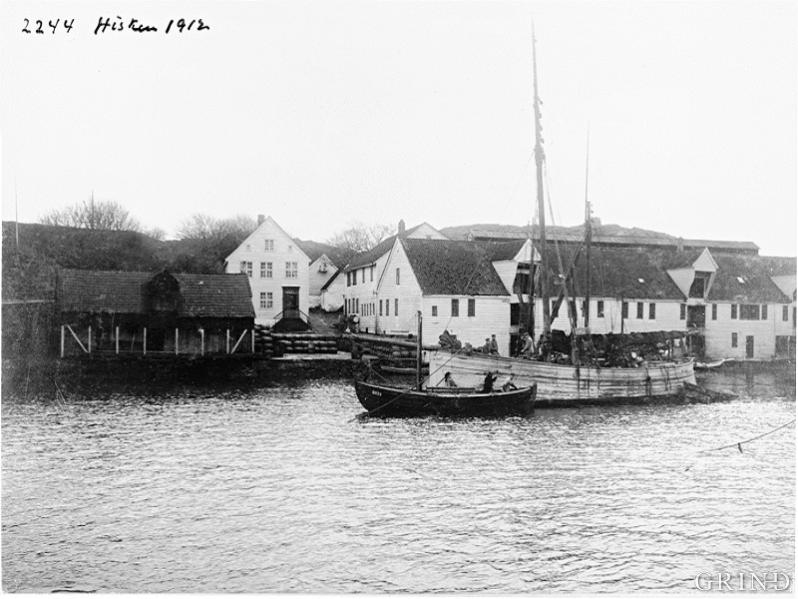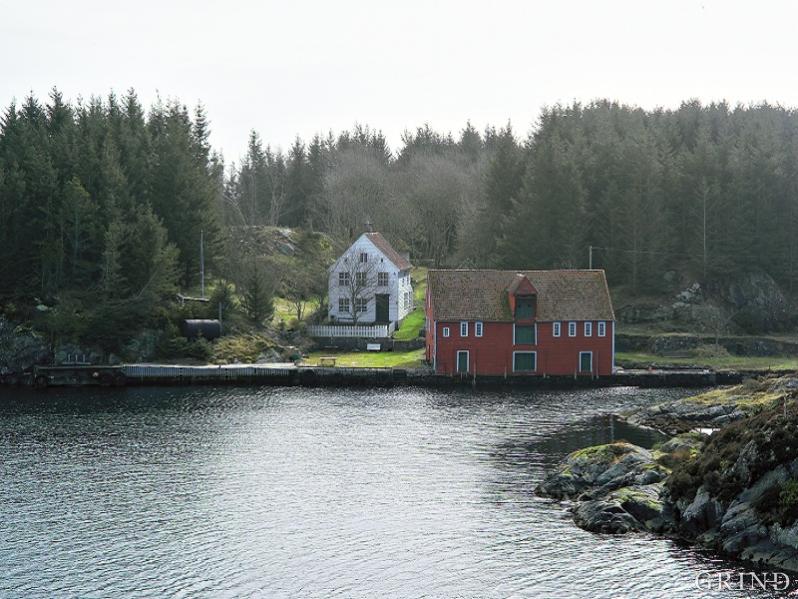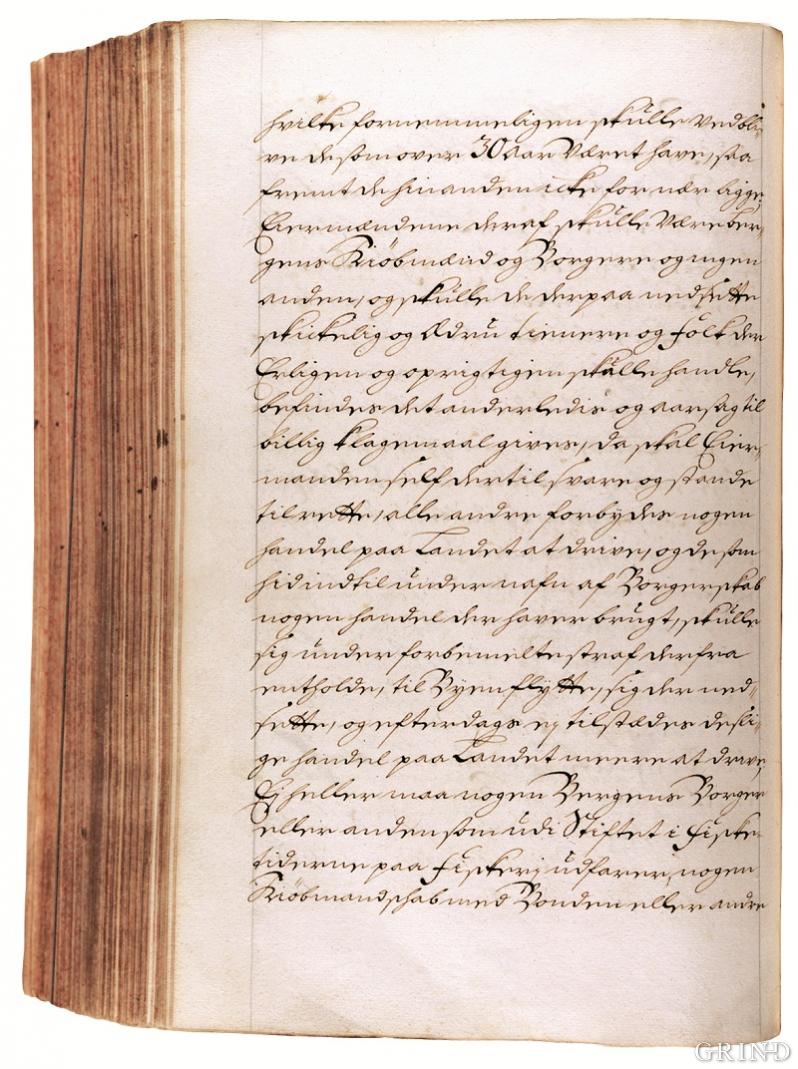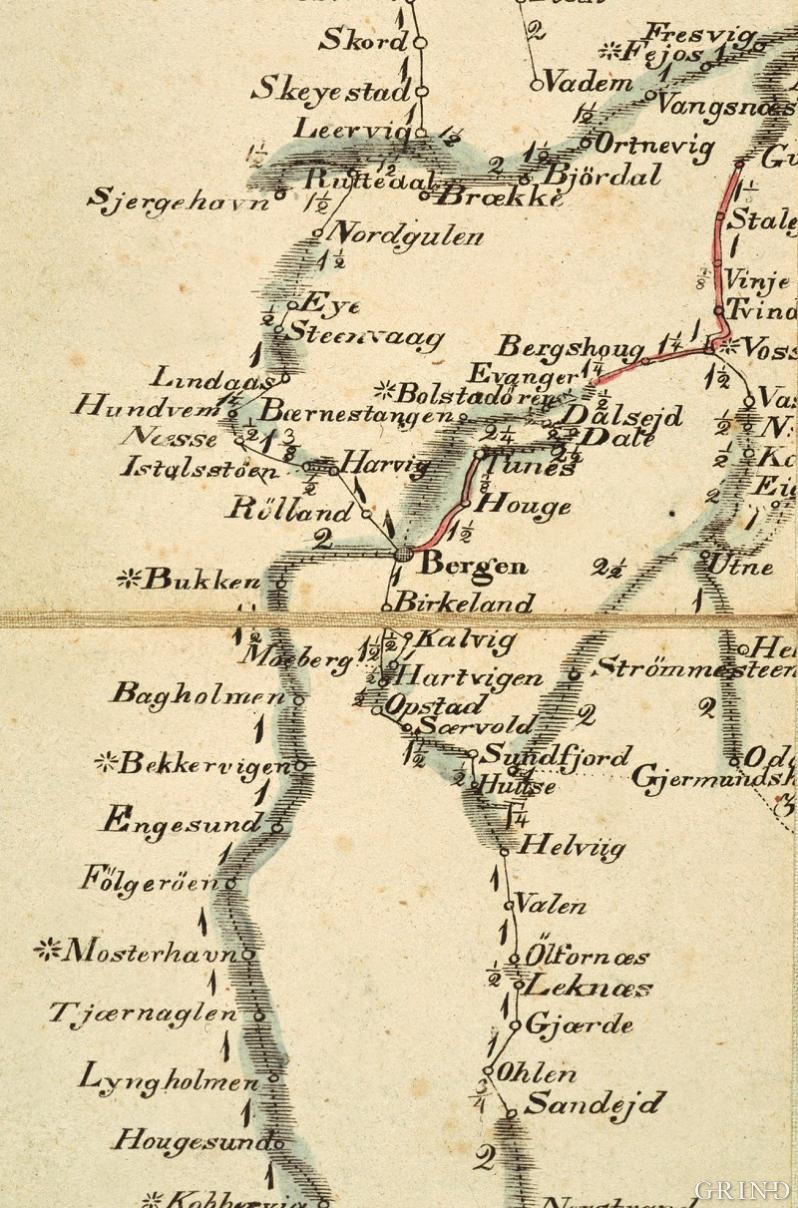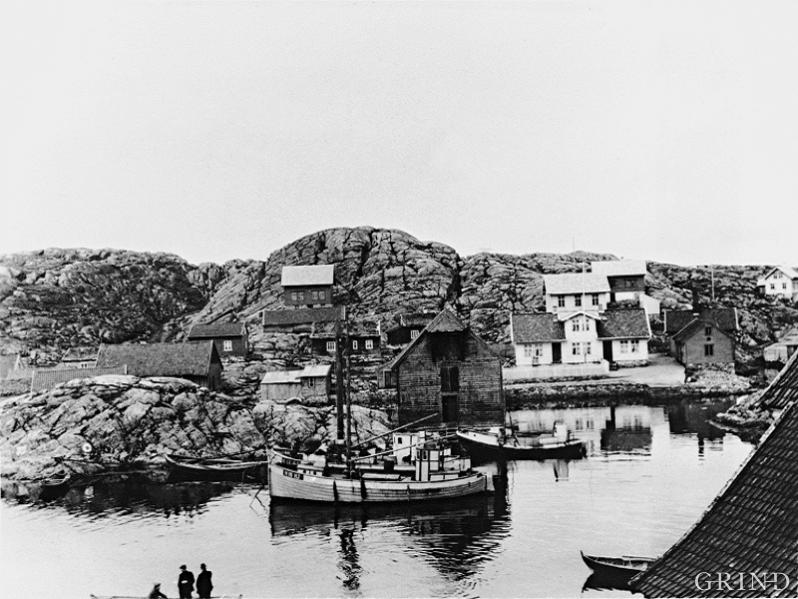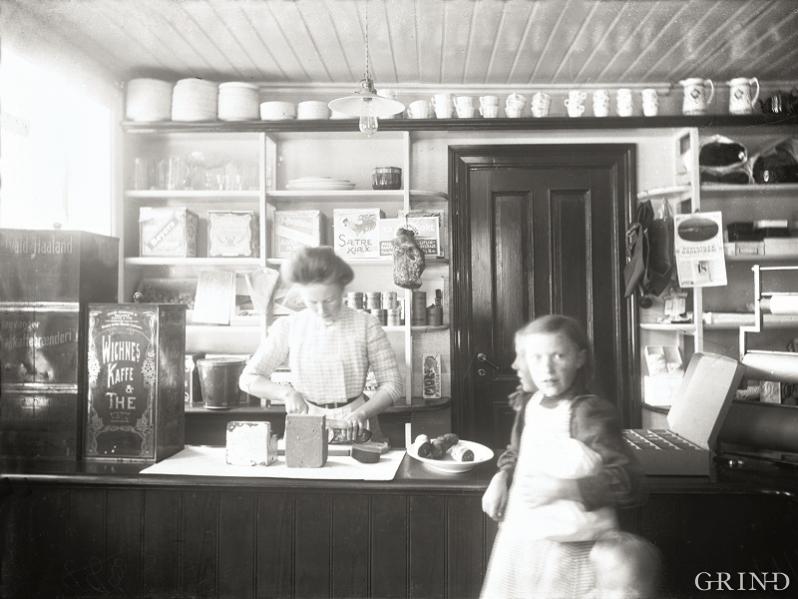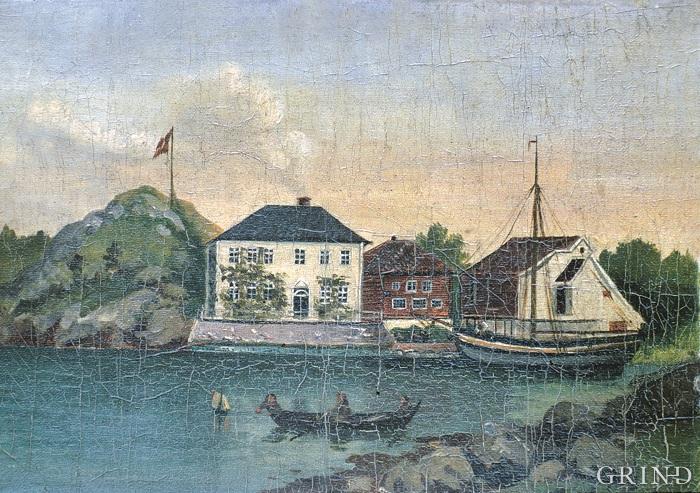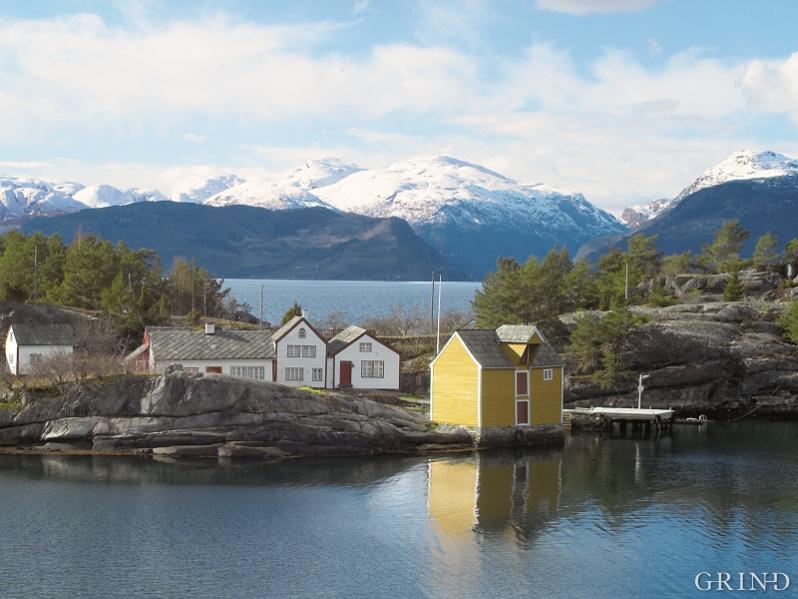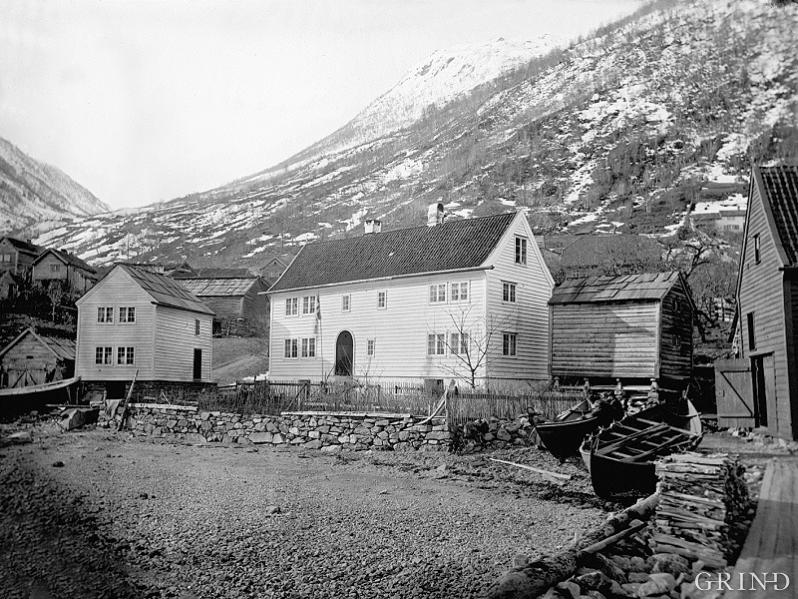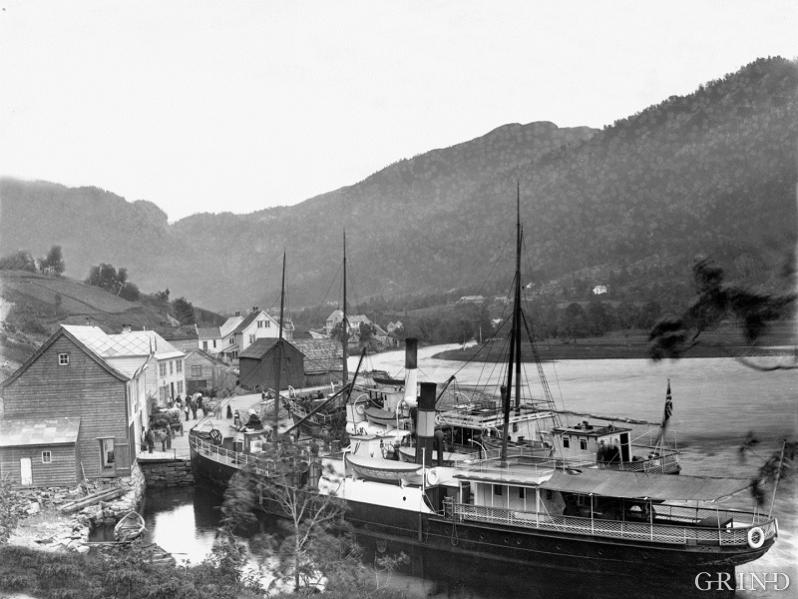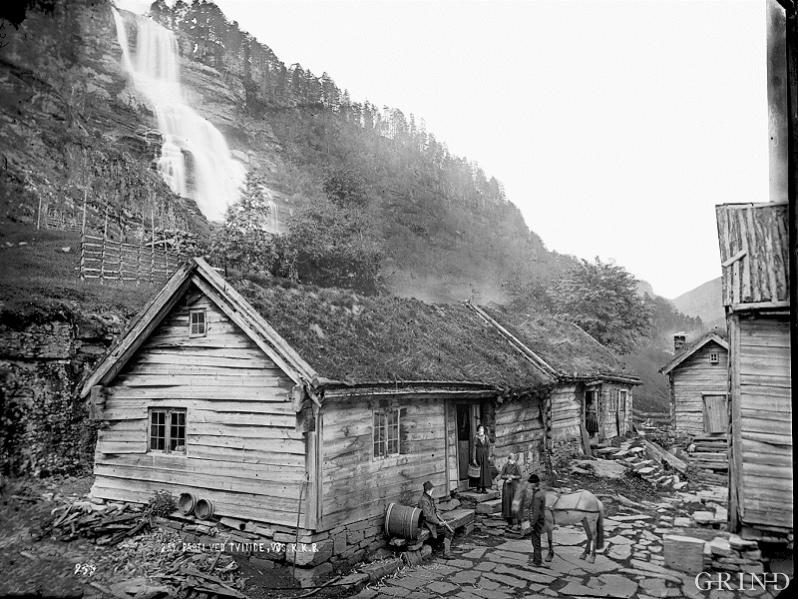Publisert: 19.05.2009 | Forfattar: Jan Henrik Munksgaard
Glesvær (Image from 1990) (Helge Sunde).
“A NECESSITY FOR THE COMMON MAND AND THE TRAVELLER”
On the way to the west
Today a motorist in Bergen has many choices. The roads lead north, south and east to a Norway in miniature with high mountains, fjords, valleys and areas with open, low terrain. But there is also a fourth possibility and that is westwards out towards the sea. The modern system of bridges has made it possible to cross large and small stretches of water so that we can come over to the most westerly islands without using a ferry. National Route 555 leads us from Bergen through Laksevåg to Sotra, the largest of these islands. The landscape with the naked mountains can seem barren and bears the stamp of its close contact with the sea. Here furthest out into the North Sea, on a side road to Glesvær, the trip stops in front of a bog, old wooden house.
The building is distinguished from the older farmhouse buildings in terms of size, form, the double room width and the style. On the other hand the house is very like the bourgeois Bergen houses built at the end of the 18th century. It has a hipped roof with a slightly curved cornice, a large sheet situated on the house’s axis, fine decorated portals and urban-type windows. This building at Glesvær is not the only old house situated with the sea as its closest neighbour. In the uttermost corners of Hordaland County similar buildings are lined up along the coast. In Mosterhamn in Bømlo Island in the south of the county there stands a two storey house with an unmistakable look of Bergen about it. The city influence is even more pronounced in Hiskjo, in the far west of the island, where the house is placed with its gable end to the sea, just as if it was on the Bryggen wharf at Bergen. In Kvalvåg on the island of Stolmen in Austevoll, yet another trading post house, and both on Hernar, right in the north of Øygarden and on Fedje, on the border with in County, larger houses have been built earlier in areas which have otherwise been dominated by the simple homes of the fishermen and farmers.
The citizens ran the trade
All these places were trading posts, or inns as they were known. One wonders why they lie right out on the sea and why they are influenced by the city’s building style. Part of the explanation lies three hundred years back in time. In the 17th century Norway had a mercantile trading policy. This meant that the towns were supposed to be the centre for trade in the country. All import and export, whether it be sugar from the West Indies or timber from Norway had to pass through or be administered from a town. It was not only foreign trade which was strictly regulated; within the country’s boundaries the trade was managed by rigorous sets of rules. As with trade with overseas, inland buying and selling was to take place in the towns. That was to say that in theory trade with intermediaries was not allowed outside the town’s boundaries. Trade in the countryside was also forbidden. To avoid unnecessary competition between the towns, each trade post was granted its sphere of interest, where they had a monopoly on trade. The towns divided the countryside up between themselves. In western Norway Bergen was the biggest town and it was given the right to trade with the farmers in Hordaland, Sogn og Fjordane and Sunnmøre. In practice this meant that if someone from Hardanger or someone from Voss wanted to get hold of goods he did not produce himself, or could barter with his neighbour, he would have to go to Bergen to purchase them. Sales were in this way strictly regulated geographically, and a sharp economic cleft between the towns and the countryside was established.
Bergen traders in the district
However in 1702 Bergen received new town privileges, and it was decided that because: “The Country-Dweller or Farmer who cannot always obtain his necessary supplies of salt, flour hamp etc, shall not be concerned without them as many trading stations shall be set up in the countryside as the authorities find necessary. The owners of these shall be citizens or merchants of Bergen and none other, and they shall then employ proper and sober servants who shall trade properly and any other person is forbidden from carrying on trade in the countryside”
This implied that the merchants from Bergen were permitted to establish trading posts out in the districts but they had to operate then through a trading assistant or a shop assistant . The most natural thing would have been for these trading posts to be distributed throughout the county, but this did not happen. Their citizens concentrated their trading in the coastal areas, and located their trading houses there. The reason was the extensive fisheries which were carried out in these areas. When the herring and the cod came close to the land, the areas were teeming with life. Hundreds of fishermen and boats were active on the sea whilst coopers made barrels by the dozens on the land.
The managers of the trade administered the servant girls and workers who were to sort the fish and put them in barrels for storage in the warehouses or for export on sailing sloops to Bergen. Glesnes, Hiskjo, Kvalvåg, Hernar and the other trading centres became in this way places for distributing fish products, and they became the extended arm of the trading citizens out in the country districts.
And it was not just any of the city’s merchants who owned and built the trading centres. It was the city’s trading “matadors” - the biggest and most influential citizens like Krohn, Ameln, Kahrs and Lexau. These citizens were naturally interested in earning as much money as possible from their trading posts, and the extensive fisheries gave much better profit than retail trading with the farmers. Most of the trading stations were therefore located in the outer coastal districts to the satisfaction of the merchant, whilst the district population in the inland areas of the county only benefited slightly from the trading centres which were originally designed for them.
The Bergen ownership structure caused the building style of the trading stations to be influenced by the architecture of whatever was in fashion in Bergen. Thus the farmhouse at Hiskholmen is almost identical to the early 18th century buildings in the city where the gable end makes up the façade and the entry door is located right on the side of the house. The main building at Glesnes which was put up a couple of generations later, has the typical features of Classicism, with an almost symmetrical facade with an overarching dormer and the entry door on the middle axis. The houses at Hiskholmen and Glesnesholmen were, despite the differences between them, both typical city houses erected in the countryside. Each one represents a central period in Bergen’s architectural history. The buildings tell us clearly that the owners were from outside the farming and fishing societies. In this way these buildings provide us with information far beyond the functions themselves.
Trade is liberalised
This arrangement with favoured, privileged trading houses out in the countryside lasted right up to 1842. It was then that a new trading law came along which implied a liberalisation of the previous regulations. It allowed people to establish country trading posts, and the owners themselves could live on the site. This meant that the dominance by Bergen slowly disappeared, as local owners started their own trading posts during the 19th century. It is these that many people will remember as small country stores with all sorts of goods on their shelves, on the floor, on the counter and hanging from the roof. Many of the old trading stations also continued as country stores even after the privilege times before 1842 were past. There is still trade on some of the oldest trading posts.
The old trading posts were, as mentioned above, established to help the local population with goods that they could not supply themselves with. Beside, the traders ran farms and produced meat, milk and wool in the same way as the farmers did. But in addition nearly all trading posts had another function. They were boarding houses or hostelries for the fishermen so that they did not have to spend the night in an open boat. The trading post and the hostelries were thus linked together.
The sea connected people while the land divided them
The hostelries did not belong to the trading systems in isolation, but to the transport system on the land. Throughout the whole of Hordaland one can find old buildings which have been boarding houses. Some of them are located on typical tourist routes where old inland connections have been extended to become modern roads but the great majority of them were and are located along the sailing channels along the coast or up the fjords.
The reason for this, of course, is that the sea was the most important means of communication a couple of hundred years ago. If one could afford it and had the opportunity people preferred a tour by row-boat instead of a tiring journey with horse and pack on small and narrow paths. On a four-oared boat or a sloop the traveller could also take more baggage, goods and freight and reach his destination more quickly than would be the case if he went by land. Boats therefore became the most significant means of transport, and the sailing channels and the fjords became the natural transport system of that time. The places with the lodging houses were naturally located along these transport routes. In a regulation from 1648 it us quite clear that it has been established for travellers so that they could “ benefit from beer, food and lodging for the night”. (Regulation of 1648). In other words the lodging houses were to meet the traveller’s needs for lodging for the night. But who were these travellers? In practice there were three types of visitor to the boarding houses. Firstly there were the travellers who used the posting system, then people who used their own horses, and thirdly the local people from the near proximity of the boarding house.
A couple of hundred years ago the posting system was the only transport system in Norway covering the whole country. Staging posts were established on a regular basis where the travellers could change staff and boats. Several farms were attached to each staging post, and the farmers were duty bound to turn up when the passengers required it. By rowing or sailing from staging post to staging post the traveller could be transported from the innermost fjords to the outermost coastal regions in a relatively short time. These staging posts were, according to the regulations, to lie within about one old Norwegian mile’s distance from each other, but in practice the distance was greater. In western Norway many staging posts were located beside a boarding house and in contrast to eastern Norway where the staging post meant a change of horses, there was a rowing crew and a boat which was changed in Hordaland. It was almost only military and civilian public servants who used the posting system in western Norway: officer, bailiffs, magistrates and priests. They travelled for free, and could require additional oarsmen and bigger boats if they were of higher rank. Other travellers who used the posting system had to pay for it. In the beginning of the 19th century the price was 24 shillings per oarsman per mile, and 8 to 32 shillings per mile for the boat, depending on the size of the boat. These were freight prices that only the fewest could afford. Most people therefore rowed and sailed in their own boats and did not make use of the posting system. On the other hand they did lodge at the boarding houses when it was necessary. That was not cheap either, so if they had the opportunity they lodged with people they knew. The result was that the boarding houses were not much visited by the ordinary traveller.
Inns and beer bottlery
The most important guests at the boarding houses were almost everywhere the farmers from the immediate vicinity. For the boarding houses were not only nodal points within the transport system, but also centrally located within the local society and they were natural meeting places for people. Therefore court meetings, council meetings and other official meetings were often held in the district’s most important boarding house. There people could hear the news, meet their acquaintances and exchange opinions. Besides there were lodging rooms or a farmer’s room where it was possible to get food and drink. The latter in particular had much to say for the visit and Mine Host always had enough drink in store. In reality many of the smaller lodging houses in western Norway were purely inns, and were often called simply beer halls. From the middle of the 18th century spirits became more popular than before, and even although the authorities in 1757, in the same way as the hotels in the rural areas in our days, forbade the sale of alcohol to others than travellers, it did not help with the sales to the local people.
In this way the lodging houses became gathering points for the rural districts’ own population, as much as they were places for lodging travellers. But in the second half pf the 19th century tourism increased, and in many places the lodging houses were converted to hotels.
Utne in Hardanger - A lodging house for 250 years
Where today’s national highways cross central points in the old system of transport, the motorist can still come upon the fine, older buildings which have been privileged lodging houses. On the national highway 550, near the ferry place at Utne, there stands a two storey wooden house which previously was a lodging house, but which is now called Utne Hotel. The place has had the same function for over 250 years. In our days thousands of holidaymakers are waiting to come over the fjord to Kvanndal. One hundred and fifty years ago not so many tourists visited Utne. During the period 1829 to 1850 only 51 persons are inscribed in the “Journal for the Posting station” . Of these 21 were public servants, 10 were English tourists and the remaining 20 were Norwegian civilians travelling in Hardanger.
For those who have the time, it is a fine experience of Nature, to drive out along the south side of the Hardanger Fjord from Utne to Jondal. They will also travel past the Herandsholmen lodging house which has long since lost its old function. But the place is still there, on a little island just outside Herandsgrenda, halfway up the fjord, and it demonstrates better than most places how a lodging house looked. The buildings are gathered together in a tight group with their facades facing the fjord. This tells of the close contact that always existed between the lodging house and the sea as a means of communication. Here are the meeting rooms, the drawing rooms, original building, the raised storehouse, the barn, the cowshed and the boathouse, like a picturesque little idyll from times gone by.
A great transport system from olden days
Many of the trading stations and lodging houses disappeared long ago, but we can still come across older buildings, influenced by the city, which had their origins in the old trading and transport system. For this we need ample time and we should travel through the fjord and coastal regions which previously were central ones, but now, with the coming of the car, lie off the beaten track. The trading stations, the lodging houses, the coaching stations and the posting farms are part of a great pattern, planned by the King’s public servants in the 17th and 18th centuries; surprisingly well organised for the conditions of the time. You either take time to travel along the sailing channels on the coast, to places which are now remote, or you travel inland up the Hardanger fjord in the wake of sloops, right up to Eide in Granvin and further along the National Highway 13 Through Flatlandsmo to Voss, and you will find that the road is much more than the shortcuts that cut through the landscape today. As far back as the 17th century the west of Norway has had a network of small and large nodal points, from shore landings and lodging houses, small coastal towns and export harbours. Many of these today are at the core of today’s urban settlements - part of the peculiar cultural geography of the west coast.
- Munksgaard, J. H. (1972-1975) Gamle handels- og gjestgiversteder på Vestlandet: registreringsrapport. Bind I-II. Bergen, Fylkeskonservatoren i Hordaland.
- Munksgaard, J. H. (1982) Bebyggelse og næringsgrunnlag: trekk fra arkitekturen i Ytre Midthordland i første halvdel av forrige århundre. I: Foreningen til norske fortidsminnesmerkers bevaring, Årbok. Oslo, Foreningen, s. 115-140.
- Munksgaard, J. H. & Irgens, K. (1976-1977) Kræmmerholmen - et vestnorsk kræmmerleie. I: Foreningen til norske fortidsminnesmerkers bevaring, Årbok. Oslo, Foreningen, s. 53-60.

